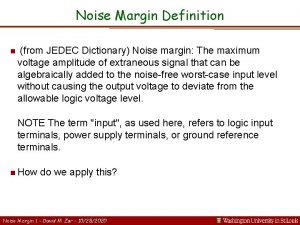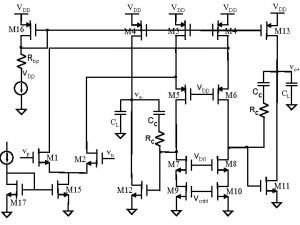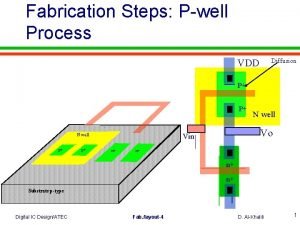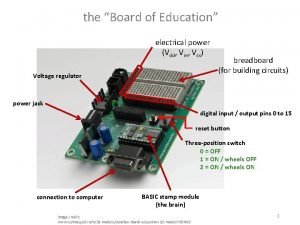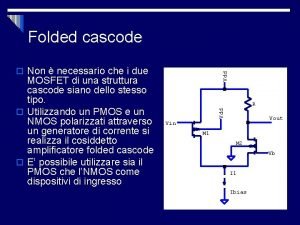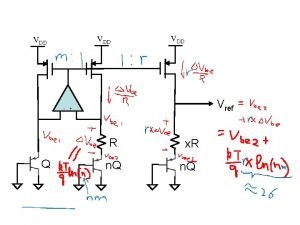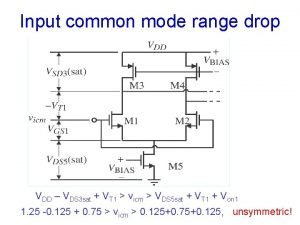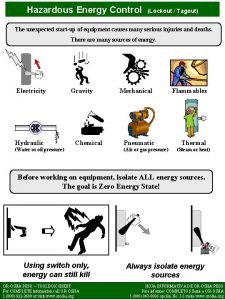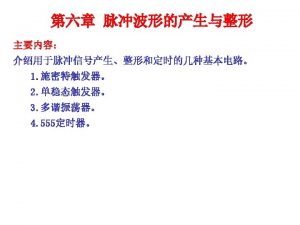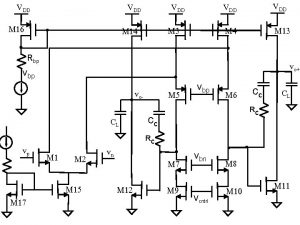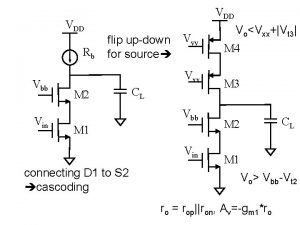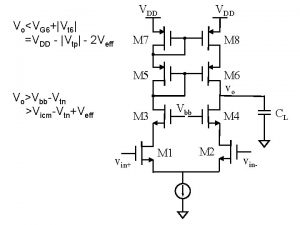Startup VDD M 3 VDD M 1 When



















- Slides: 19

Start-up VDD M 3 VDD M 1 When Vd 4=Vg 4 < Vdd-|Vtp|, want Ms off M 4 Ms When Vd 4=Vg 4 > Vdd-|Vtp|, want Ms on VB make VB ~ Vdd 2|Vtp| to Vdd-2|Vtp|-Veff M 2 Also make IQ in right branch to be very small.

Temperature independent reference Generate a negatively PTAT (Proportional To Absolute Temperature) and a positively PTAT quantities and sum them appropriately. X can be voltage or current

Bandgap voltage reference Works in bipolar or Bi. CMOS Chapter 7 Figure 09

A Common way of bandgap reference This is easily available in digital CMOS DVBE k. T/q

VBE has negative temp coeff at roughly -2. 2 m. V/°C at room temperature, called CTAT or NTAT Vt = k. T/q is PTAT that has a temperature coefficient of +0. 085 m. V/°C at room temperature. Multiply Vt by a constant K and sum it with the VBE to get VREF = VBE + KVt If K is right (2. 2/0. 085 26), temperature coefficient can be zero.

In general, use VBE + VPTAT

Bandgap reference still varies a little with temp

How to get Bipolar in CMOS?

Layout P-active is E N-well is B P-substrate is C Tie both n-well and p-substrate to Vss Issues: this will not pass LVS Cadence does not know how to simulate

DVbe = ln(n)k. T/q VDD VDD 1: 1 Dvbe/R - + Vbe 1 R Vbe 2 Q + DVbe n. Q Ise. Vbe 1/vth = n. Ise. Vbe 2/vth + x. R x. DVbe n. Q Vref = x. DVbe + Vbe = xln(n)k. T/q + Vbe = xln(n)0. 026 + 0. 6

VDD VDD 1: 1 Vref - + R Q x. R 8 Q 8 Q

Design Steps • Convenient ratio: n=8 • Select desired current I (e. g. 10 u. A) • Select R by making I = ln(n)k. T/q/R R = ln(8)*26 m. V/10 u. A • Select x. R to make Vref = 1. 26 V x = 0. 65 V/26 m. V/ln(8) • Trim x. R to make Vref correct

Adding more degrees of freedom VDD VDD m: 1 1: r Vref - + R Q n. Q x. R n. Q

R 1 and R 3 equal and equal to x. R 2 Q 2 = n. Q 1 Design steps are identical to before. Chapter 7 Figure 13

These are popular structures, but not doable in CMOS Chapter 7 Figure 11 Chapter 7 Figure 10

Cascoded CM Cascoded CG amplifier

Chapter 7 Figure 15

Banba, Hironori, Hitoshi Shiga, Akira Umezawa, Takeshi Miyaba, Toru Tanzawa, Shigeru Atsumi, and Koji Sakui. "A CMOS bandgap reference circuit with sub-1 -V operation. " Solid-State Circuits, IEEE Journal of 34, no. 5 (1999): 670 -674.

 Vdd urban dictionary
Vdd urban dictionary Vdd m
Vdd m Vdd
Vdd Vcc vs vdd
Vcc vs vdd Vdd vin
Vdd vin Vdd mosfet
Vdd mosfet Configurazione cascode
Configurazione cascode Cm=n/vdd
Cm=n/vdd Vdd
Vdd Unexpected startup
Unexpected startup Customer interviews lean startup
Customer interviews lean startup Bash startup files
Bash startup files Cofounder brain startup company
Cofounder brain startup company Startup weekend san francisco
Startup weekend san francisco Startup development phases
Startup development phases Curve pitch deck
Curve pitch deck เฉลย my english lab startup 2
เฉลย my english lab startup 2 Pitch deck biotech
Pitch deck biotech Mapa empatii
Mapa empatii John ousterhout
John ousterhout
